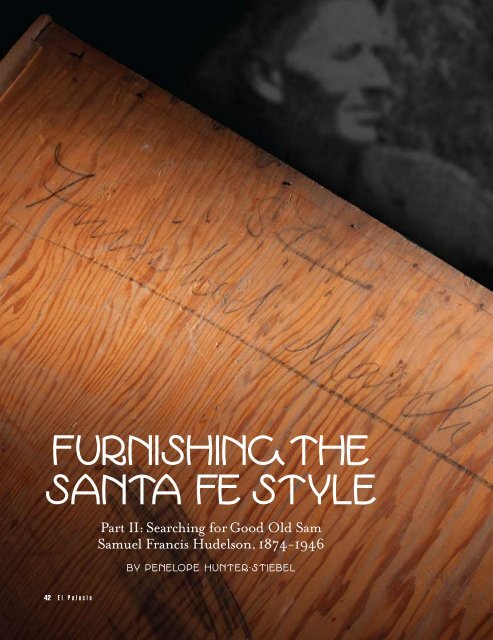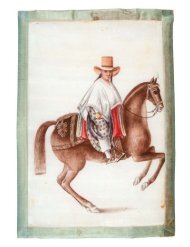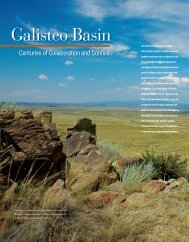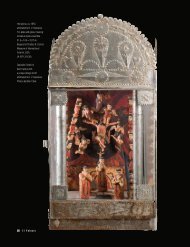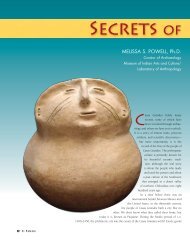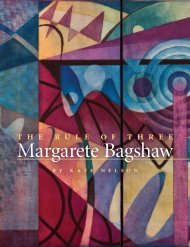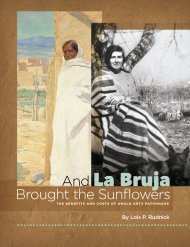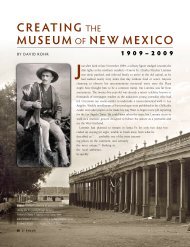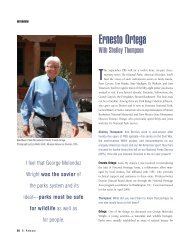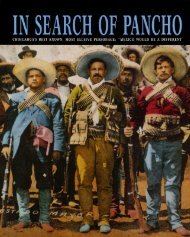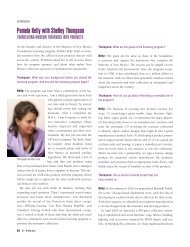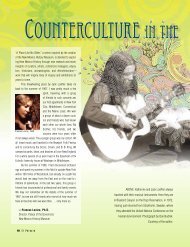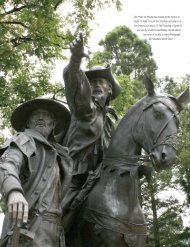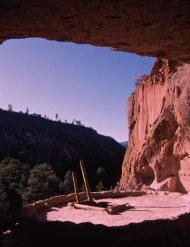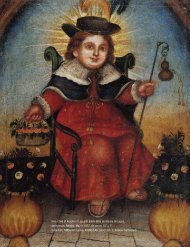Furnishing the Santa Fe Style - El Palacio Magazine
Furnishing the Santa Fe Style - El Palacio Magazine
Furnishing the Santa Fe Style - El Palacio Magazine
Create successful ePaper yourself
Turn your PDF publications into a flip-book with our unique Google optimized e-Paper software.
<strong>Furnishing</strong> <strong>the</strong><br />
<strong>Santa</strong> <strong>Fe</strong> <strong>Style</strong><br />
Part II: Searching for Good Old Sam<br />
Samuel Francis Hudelson, 1874-1946<br />
By Penelope Hunter-Stiebel<br />
42 <strong>El</strong> <strong>Palacio</strong>
Much of <strong>the</strong> furniture created for <strong>the</strong> New<br />
Mexico Museum of Art over <strong>the</strong> years since<br />
its opening in 1917 still exists in galleries<br />
and storage areas. Beyond Jesse Nusbaum’s readily identifiable<br />
contributions based on local Hispanic tradition<br />
lay a mystery. In a group of significant works an accomplished<br />
furniture maker had continued Nusbaum’s<br />
vocabulary while introducing elements from various<br />
Native American cultures. Who might be <strong>the</strong> author of<br />
this evidence of a developing triculturalism in <strong>the</strong> <strong>Santa</strong><br />
<strong>Fe</strong> style? And when were <strong>the</strong>se pieces made?<br />
Above: Desk carved with Indian motifs that provided <strong>the</strong> key for identifying<br />
<strong>the</strong> furniture of Sam Hudelson. The file drawer is carved with <strong>the</strong> initials<br />
of <strong>the</strong> Museum of New Mexico. Photograph by Blair Clark. All furniture<br />
made for <strong>the</strong> Museum of Art pictured here and throughout is shown courtesy<br />
of <strong>the</strong> New Mexico Museum of Art. Left: Pencil notation under <strong>the</strong><br />
center drawer of <strong>the</strong> desk with <strong>the</strong> initials of Samuel Francis Hudelson and<br />
dating his completion of <strong>the</strong> assignment to March 10, 1934, with emphatic<br />
flourish and underline. Photograph by Blair Clark.
SAM HUDELSON<br />
Firm in <strong>the</strong> belief that all <strong>the</strong> contents of <strong>the</strong> museum<br />
should be documented, Registrar Michelle Gallagher Roberts<br />
assigned her colleague Dan Goodman (now curator of collections<br />
at <strong>El</strong> Rancho de las Golondrinas) to work with me, and<br />
toge<strong>the</strong>r we photographed, measured, and recorded every<br />
piece we could find. Most bore inventory numbers assigned<br />
in 1990, but no fur<strong>the</strong>r study had been undertaken to determine<br />
<strong>the</strong>ir author or date.<br />
Moving what appeared to be a battered radiator cover with<br />
elaborate carved Indian-style decoration out from under a<br />
window recess in a corner of a gallery, we found it to be a<br />
desk with <strong>the</strong> initials MNM carved on <strong>the</strong> front of <strong>the</strong> deep file<br />
drawer, clearly indicating official use for <strong>the</strong> Museum of New<br />
Mexico. But it was <strong>the</strong> shallow center drawer that provided<br />
<strong>the</strong> Eureka moment: when we removed <strong>the</strong> drawer we discovered<br />
scrawled in pencil underneath “SFH/ Finished March<br />
10-34.” We now had a lynchpin!<br />
Over <strong>the</strong> months when Dan could fit periodic furniture<br />
forays into his full schedule I was researching in libraries and<br />
archives where I had picked up on <strong>the</strong> name Sam Huddleson,<br />
Huddelson, or Hudelson, variously spelled. He had been<br />
officially added to <strong>the</strong> Museum of New Mexico staff in 1920<br />
as superintendent, with responsibility for <strong>the</strong> Palace of <strong>the</strong><br />
Governors and <strong>the</strong> Art Gallery (as <strong>the</strong> New Mexico Museum<br />
of Art was originally called) buildings, <strong>the</strong>n jointly administered<br />
with <strong>the</strong> School of American Research (SAR, now School<br />
of Advanced Research) under <strong>the</strong> founding director Edgar L.<br />
Hewett. “Superintendent” was <strong>the</strong> same title held by Jesse<br />
Nusbaum before his departure from <strong>Santa</strong> <strong>Fe</strong> in December<br />
1917. Fur<strong>the</strong>r, Nusbaum in his memoirs credited Hudelson<br />
as one of <strong>the</strong> “good men” he had helping with <strong>the</strong> elaborate<br />
architectural woodwork he designed for <strong>the</strong> art museum. 1<br />
Finding S. F. H.<br />
What singled Hudelson out to me was <strong>the</strong> artist Will Shuster’s<br />
passing reference in a 1940 interview as he described <strong>the</strong><br />
scene in <strong>the</strong> art museum basement: “There’s Sam Huddleson<br />
[sic] presiding over a carpentry shop where Joe Bakos and<br />
Fremont <strong>El</strong>lis and several o<strong>the</strong>r artists are busy making frames<br />
and crating paintings . . . good old Sam ready to lend a helping<br />
hand or a bit of advice.” 2<br />
I couldn’t even be sure that “good old Sam” was <strong>the</strong> SFH<br />
written under <strong>the</strong> desk drawer as I could find no mention of<br />
a middle name—at least until I opened a manila envelope<br />
in <strong>the</strong> Fray Angélico Chávez History Library, crammed with<br />
Sam Hudelson posing with an unidentified “Indian Friend” in <strong>El</strong> <strong>Palacio</strong> 50 (7),<br />
July 1943. Hudelson taught “industrial arts” for <strong>the</strong> Indian Service on several<br />
reservations before coming to <strong>Santa</strong> <strong>Fe</strong> in 1912 to work with Jesse Nusbaum on<br />
<strong>the</strong> renovation of <strong>the</strong> Palace of <strong>the</strong> Governors. He held <strong>the</strong> post of superintendent<br />
for <strong>the</strong> Museum of New Mexico from 1920 until 1941.<br />
yellowed newspaper clippings. I carefully removed each crumbling,<br />
irrelevant bit of trivia published in <strong>the</strong> <strong>Santa</strong> <strong>Fe</strong> New<br />
Mexican mentioning <strong>the</strong> Museum of New Mexico until out<br />
came a one-paragraph obituary published on June 7, 1946, for<br />
“Hudelson, Samuel Francis,” stating he had been custodian of<br />
<strong>the</strong> Museum of New Mexico. At last <strong>the</strong> correct spelling and<br />
his middle name!<br />
The information that he had retired eight years earlier<br />
proved incorrect, but it sent me to back issues of <strong>El</strong> <strong>Palacio</strong> to<br />
see if <strong>the</strong> fact was mentioned. An appreciation of his service<br />
in <strong>the</strong> July 1943 issue revealed that he had actually retired in<br />
1941. In a brief biography, Assistant Editor Hulda R. Hobbs<br />
wrote that this son of a Texas rancher had come to <strong>Santa</strong><br />
44 <strong>El</strong> <strong>Palacio</strong>
SAM HUDELSON<br />
Hudelson’s photograph (ca. 1925–30) of his workshop in <strong>the</strong> basement of <strong>the</strong> New Mexico Museum of Art showing <strong>the</strong><br />
armchairs and table made for <strong>the</strong> Women’s Board Room in <strong>the</strong> foreground. The premises were frequently visited by artists and<br />
admirers, and, on his retirement, Hudelson was credited with “inaugurating <strong>the</strong> local renaissance of hand-made and handdecorated<br />
furniture.” Courtesy Palace of <strong>the</strong> Governors Photo Archives (NMHM/DCA), Neg. No. 091790.<br />
<strong>Fe</strong> in 1912 when he worked on Jesse Nusbaum’s project of<br />
remodeling <strong>the</strong> Palace of <strong>the</strong> Governors, doing cabinetwork<br />
and continuing improvements, as well as <strong>the</strong> ornamental<br />
woodwork for <strong>the</strong> new Art Gallery. Hobbs credited Hudelson<br />
“with inaugurating <strong>the</strong> local renaissance of hand-made and<br />
hand-decorated furniture.” Now I knew that I was on <strong>the</strong><br />
right track!<br />
Hobbs’s claim about <strong>the</strong> significance of Hudelson’s contributions<br />
to furniture design is all <strong>the</strong> more amazing considering<br />
that Hudelson’s primary responsibility was maintenance,<br />
repair, and additions to <strong>the</strong> Museum of New Mexico campus<br />
(both <strong>the</strong> Palace of <strong>the</strong> Governors and <strong>the</strong> Art Museum). He<br />
also did field work every year with SAR working at Gran<br />
Quivira and Quarai, Jemez, Puyé, Chaco, Pecos, and Acoma.<br />
Hobbs quoted an official statement from Hewett (notoriously<br />
loath to credit his staff) saying, with uncharacteristic enthusiasm,<br />
“What this capable workman (artist as well as master<br />
mechanic) accomplished assisted by a few unskilled laborers,<br />
was beyond praise…. His methods have influenced <strong>the</strong> work<br />
of about all of us who have had to do with <strong>the</strong> preservation of<br />
ruins during this generation.”<br />
Furniture for Private Clients<br />
Hudelson himself was not a man of words, or at least not of<br />
written words. The only records that he made relating to <strong>the</strong><br />
Museum of Art that I could find were his photographs, now<br />
in <strong>the</strong> Photo Archives of <strong>the</strong> Palace of <strong>the</strong> Governors. A key<br />
image had been published by Lonn Taylor and Dessa Bokides<br />
in <strong>the</strong>ir invaluable book, New Mexican Furniture, 1600–1940. 3<br />
It showed furniture in <strong>the</strong> Art Museum basement with two<br />
of <strong>the</strong> armchairs for <strong>the</strong> Women’s Board Room in front of <strong>the</strong><br />
room’s long table, which was up on saw horses. No trace has<br />
been found of <strong>the</strong> foreground bench or <strong>the</strong> second table in <strong>the</strong><br />
background. Could <strong>the</strong>se have been made for a private client?<br />
Hewett was notoriously stingy when it came to paying his<br />
staff, who worked for both <strong>the</strong> museum and SAR. Most were<br />
considered “part time” employees and expected to supplement<br />
<strong>the</strong>ir salaries with outside work.<br />
It was just such extracurricular work that forced Hudelson<br />
to put words in writing. I was led to <strong>the</strong> SAR library archive<br />
by Kathy Fiero, who is writing a biography of Nusbaum<br />
and shared with me an unpublished manuscript by Lonn<br />
Taylor on <strong>the</strong> construction and furnishing of <strong>the</strong> Martha and<br />
<strong>El</strong> <strong>Palacio</strong> 45
SAM HUDELSON<br />
<strong>El</strong>izabeth White house now occupied by SAR. 4 Although <strong>the</strong>y<br />
engaged as <strong>the</strong>ir architect William Penhallow Henderson, who<br />
developed a furnituremaking business, <strong>the</strong> White sisters wrote<br />
to Nusbaum that <strong>the</strong>y wanted furniture like that <strong>the</strong>y had seen<br />
in his home at Mesa Verde. Since he was <strong>the</strong>n fully occupied<br />
with his duties as superintendent of Mesa Verde National<br />
Park, Nusbaum said from <strong>the</strong> start that he could design <strong>the</strong><br />
pieces but that <strong>the</strong>y would have to be made by Hudelson in<br />
his shop in <strong>the</strong> museum basement. An agreement was struck<br />
for twenty-two pieces, and correspondence between <strong>the</strong><br />
Whites, Nusbaum, and Hudelson covering 1923–25 in <strong>the</strong><br />
SAR archives reveals a dynamic collaboration with sketches<br />
and measured drawings and commentary. 5 I found a number<br />
of <strong>the</strong> pieces documented in photographs by Hudelson among<br />
<strong>the</strong> images he donated to <strong>the</strong> museum, now in <strong>the</strong> Palace<br />
of <strong>the</strong> Governors Photo Archives. The project stirred great<br />
interest, and visits to Hudelson’s basement workshop were so<br />
frequent that Nusbaum wrote him, “Who comes <strong>the</strong> most to<br />
offer suggestions and criticisms of ‘Grand Rapids.’ Nordfelt<br />
[<strong>the</strong> painter. J. O Nordfelt (1878-1955), I suppose]. Guess he<br />
will be imitating lot of things later in his house if I do not miss<br />
my guess.” There was also correspondence with <strong>the</strong> museum’s<br />
assistant director, Paul Walter, about <strong>the</strong> possibility of an exhibition<br />
which never came about.<br />
The White furniture was just one of Hudelson’s furniture<br />
commissions: in a letter to Nusbaum dated March 10, 1924,<br />
Hudelson wrote, “contracted 2 large chairs—4 benches—one<br />
thin table $390.00 for a lady here. Will begin as soon as [I]<br />
finish yours.” Clearly <strong>the</strong>se pieces were of Hudelson’s own<br />
design and may represent an extended production that is yet<br />
to be identified.<br />
The clue to identifying Hudelson’s independent work lies<br />
in <strong>the</strong> carved ornament. In a letter dated March 7, 1924,<br />
Nusbaum complained to Martha White “he [Hudelson] was<br />
too ambitious in carving and everywhere he could lay a dollar<br />
down on it, he had to carve it, That ruins it for me…” 6<br />
Examining <strong>the</strong> Museum of Art furniture, we may not agree<br />
with his assessment of a developing style born of Hudelson’s<br />
personal experience.<br />
From <strong>the</strong> 1943 <strong>El</strong> <strong>Palacio</strong> article I learned that at age nineteen<br />
Hudelson was hired as a teacher of “industrial arts” for<br />
<strong>the</strong> Indian service. Starting in Oklahoma, where his parents<br />
had homesteaded, he was transferred to San Carlos Apache<br />
school in Rice, Arizona; <strong>the</strong>n to Fort Dermitt, Nevada, on <strong>the</strong><br />
Paiute Reservation; and finally to Tohatchi, New Mexico, on<br />
<strong>the</strong> Navajo Reservation, before coming to <strong>Santa</strong> <strong>Fe</strong> in 1911.<br />
Putting this toge<strong>the</strong>r with what was happening at <strong>the</strong> museum<br />
from <strong>the</strong> time of Nusbaum’s departure, <strong>the</strong> rationale behind<br />
<strong>the</strong> museum furnishings came into focus.<br />
This varied experience of Native American communities<br />
combined well with <strong>the</strong> museum’s increased focus on contemporary<br />
Indian arts. What Hewett called “The <strong>Santa</strong> <strong>Fe</strong><br />
Program” started with promoting a revival of pottery at San<br />
Ildefonso and moved on to <strong>the</strong> presentation of Pueblo painters<br />
in <strong>the</strong> Art Gallery. Two breakthrough exhibitions of students<br />
of <strong>Santa</strong> <strong>Fe</strong> Indian school in 1919 brought a “new” art form<br />
to <strong>the</strong> attention of <strong>the</strong> Anglo community. In 1924 <strong>the</strong> Art<br />
Gallery’s eleventh annual survey exhibition presented as usual<br />
<strong>the</strong> latest paintings by members of <strong>the</strong> Taos and <strong>Santa</strong> <strong>Fe</strong> artists<br />
colonies, but also dedicated <strong>the</strong> upstairs gallery to paintings<br />
by Indian artists. Fur<strong>the</strong>r, <strong>the</strong> report in <strong>the</strong> September 24<br />
<strong>El</strong> <strong>Palacio</strong> stated that in <strong>the</strong> arts and crafts section where work<br />
was presumably by non-Indians, “<strong>the</strong> application of Indian<br />
designs as applied to <strong>the</strong> decoration of china and was of high<br />
merit and attracted much attention.” The 1934 frescoes by<br />
Will Shuster in <strong>the</strong> museum patio illustrating Pueblo Indian<br />
scenes left a lasting reminder of <strong>the</strong> institution’s involvement.<br />
Hudelson’s Distinctive Designs<br />
Kenneth Chapman stands out as a pioneer in <strong>the</strong> appreciation<br />
of Indian design. As Hewett’s first employee at <strong>the</strong> museum<br />
and SAR he devoted whatever hours could be spared from<br />
administrative duties to begin a life-long study of Pueblo<br />
ceramics, analyzing <strong>the</strong> decorations and working <strong>the</strong>m up in<br />
hundreds of sheets of watercolor studies. Under <strong>the</strong> auspices<br />
of <strong>the</strong> WPA he even conducted classes where artists emulated<br />
This ca. 1923 photograph by <strong>the</strong> Cross Studio shows a Hudelson bench in situ.<br />
Courtesy Palace of <strong>the</strong> Governors Photo Archives (NMHM/DCA), Neg. No. 022975.<br />
46 <strong>El</strong> <strong>Palacio</strong>
Benches carved with Pueblo and Navajo motifs Hudelson made to cover radiators and provide<br />
supplemental seating in <strong>the</strong> Women’s Board Room by <strong>the</strong> early 1920s. Photographs by Blair Clark.<br />
<strong>El</strong> <strong>Palacio</strong> 47
Left: A small bookcase whose carvings, including a swastika, traditional in<br />
Navajo weaving, allow <strong>the</strong> piece to be dated before <strong>the</strong> motif was associated <strong>the</strong><br />
threat of Hitler’s Nazi party. Photograph by Blair Clark.<br />
his process. He created a lens through which Anglo admirers<br />
perceived this form of ceramic art, and Indian motifs entered<br />
<strong>the</strong> vocabulary of contemporary decoration.<br />
Hudelson’s initial use of Indian-style ornament may have<br />
been in two benches supplied to provide additional seating<br />
and cover <strong>the</strong> radiators in <strong>the</strong> Women’s Board Room, as shown<br />
in photographs from <strong>the</strong> early 1920s. On one he carved friezes<br />
and stepped motifs in common use in <strong>the</strong> pueblos, and on <strong>the</strong><br />
o<strong>the</strong>r he carved openings in <strong>the</strong> low back that recall motifs of<br />
Navajo rugs.<br />
Early in our exploration Dan Goodman and I stumbled<br />
across a small bookcase in <strong>the</strong> museum storage. The carvings<br />
of <strong>the</strong> sides are almost a lexicon of Southwest Indian design.<br />
The inclusion of <strong>the</strong> design of <strong>the</strong> swastika that had long figured<br />
in Navajo weaving told us that <strong>the</strong> piece had to predate<br />
American awareness of <strong>the</strong> threat from Hitler, who had appropriated<br />
<strong>the</strong> age-old symbol for his Nazi party.<br />
A double bench still in use in <strong>the</strong> galleries recalls <strong>the</strong> commercial<br />
“Mission style” of <strong>the</strong> benches purchased by Hewett<br />
for <strong>the</strong> gallery opening, but <strong>the</strong> outlines are softened and <strong>the</strong><br />
sides with cut-out slats below incised Indian-inspired motifs<br />
convey a distinct Southwest character.<br />
Were <strong>the</strong> Indian motifs Hudelson carved on <strong>the</strong> art museum<br />
furniture copied from Chapman’s designs? After examining a<br />
number of Chapman’s works I felt <strong>the</strong> carvings were of a very<br />
different character. I was vastly relieved when Dody Fugate,<br />
assistant curator for archaeological research collections at <strong>the</strong><br />
Laboratory of Anthropology, confirmed my observation, saving<br />
me hours and hours of poring over still more Chapmania.<br />
Most of Hudelson’s carvings are free improvisations adapting<br />
Indian design elements, from Mimbres pots to Navajo weavings,<br />
drawn from his personal experience. There were two<br />
outstanding exceptions, however. One was <strong>the</strong> front panel on<br />
a small reception desk. On seeing my snapshot, Dody cried<br />
out, “That’s a Hopi pot!” as indeed <strong>the</strong> carved bird design<br />
resembles that painted on a Hopi pot that she led me to on <strong>the</strong><br />
shelves of <strong>the</strong> Museum of Indian Arts & Culture storeroom.<br />
In <strong>the</strong> second case I already knew <strong>the</strong> source, since Dody<br />
had published it in her recent <strong>El</strong> <strong>Palacio</strong> article coauthored<br />
with Pete Pino. I recognized <strong>the</strong> sun symbol carved on <strong>the</strong> side<br />
of <strong>the</strong> chest of shallow drawers in <strong>the</strong> museum basement and<br />
also on <strong>the</strong> side of a desk that has has been traditionally called<br />
48 <strong>El</strong> <strong>Palacio</strong>
SAM HUDELSON<br />
Above: A double bench still used in <strong>the</strong> museum galleries. Its softened<br />
“Mission” style is given Southwestern character by <strong>the</strong> cut-out slats and<br />
Indian-inspired engraving at each end. Photograph by Blair Clark.<br />
Right: Small reception desk with <strong>the</strong> front panel carved with a motif<br />
similar to those on Hopi pottery. Photograph by Blair Clark.<br />
<strong>El</strong> <strong>Palacio</strong> 49
SAM HUDELSON<br />
The “Director’s desk” with <strong>the</strong> initials of <strong>the</strong> Museum of New Mexico on <strong>the</strong><br />
file drawer. It can be dated to around 1931–32 and still serves as <strong>the</strong> work station<br />
of <strong>the</strong> current director of <strong>the</strong> Art Museum, Mary Kershaw, who graciously allowed it<br />
to be cleared for photography. The side panel of “<strong>the</strong> Director’s desk” exactly<br />
replicates <strong>the</strong> motif on an important Zia pot. Adapted by <strong>the</strong> addition of a fourth<br />
ray and <strong>the</strong> elimination of <strong>the</strong> sun’s facial features, <strong>the</strong> motif was <strong>the</strong> winning entry<br />
in <strong>the</strong> 1920 competition for a New Mexico state flag. Hudelson would have been<br />
familiar with <strong>the</strong> original pot that was donated by <strong>the</strong> painter Andrew Dasburg to<br />
<strong>the</strong> School of American Research in 1931 and housed in <strong>the</strong> museum buildings in<br />
Hudelson’s charge. Photograph by Blair Clark.<br />
and remains in use as “<strong>the</strong> Director’s desk.” Both of <strong>the</strong>se<br />
carvings differ in character from <strong>the</strong> symbol as adopted for<br />
<strong>the</strong> New Mexico state flag, with only three, not four rays. The<br />
sun on <strong>the</strong> Director’s desk has a face, with eyes and mouth.<br />
I had not realized until <strong>the</strong> Fugate/Pino article that this was<br />
precisely <strong>the</strong> decoration on <strong>the</strong> Zia pot donated to SAR in<br />
1931 by <strong>the</strong> painter Andrew Dasburg and recently repatriated.<br />
Hudelson would certainly have known <strong>the</strong> celebrated<br />
acquisition. He would have been well acquainted with ceramics<br />
in <strong>the</strong> collection, as he would have relocated <strong>the</strong>ir storage<br />
on <strong>the</strong> repeated occasions when Hewett reassigned spaces in<br />
<strong>the</strong> museum buildings.<br />
Inset: The Zia pot that inspired<br />
Hudelson’s carvings and <strong>the</strong> New<br />
Mexico flag. Courtesy Peter Pino<br />
and <strong>the</strong> Pueblo of Zia.<br />
Several pieces in <strong>the</strong> art museum that have elements suggesting<br />
Hudelson’s work give evidence of being subsequently<br />
heavily reworked and/or transformed by succeeding generations<br />
of carpenters. The huge table currently occupying <strong>the</strong><br />
location of <strong>the</strong> original table made for <strong>the</strong> Women’s Board<br />
Room, which is now in <strong>the</strong> museum lobby, appears to be<br />
a composite. The Indian motifs carved on <strong>the</strong> apron are in<br />
Hudelson’s style but <strong>the</strong>y include one carved on <strong>the</strong> inside<br />
of <strong>the</strong> apron, indicating <strong>the</strong> wood was a trial piece or salvaged<br />
from ano<strong>the</strong>r use. As in <strong>the</strong> 1917 original, <strong>the</strong> massive<br />
Solomonic spiral column legs are hand-hewn, but <strong>the</strong> overall<br />
proportions are awkward, being exaggerated in length with a<br />
single central stretcher and a shallow apron. The structure is<br />
held toge<strong>the</strong>r with metal plates bracing <strong>the</strong> corners, unthinkable<br />
for a craftsman of Hudelson’s caliber.<br />
50 <strong>El</strong> <strong>Palacio</strong>
A chest with shallow drawers,<br />
probably intended for works on paper.<br />
Here Hudelson enhanced <strong>the</strong> decorative<br />
vocabulary Nusbaum based in regional<br />
Hispanic tradition for <strong>the</strong> Women’s Board<br />
Room with Pueblo motifs, including <strong>the</strong> Zia<br />
sun symbol on <strong>the</strong> sides. Hudelson’s<br />
furniture for <strong>the</strong> museum illustrated<br />
<strong>the</strong> institution’s active promotion of <strong>the</strong><br />
aes<strong>the</strong>tic value of Native American art and<br />
fur<strong>the</strong>r amplified <strong>the</strong> developing “<strong>Santa</strong> <strong>Fe</strong><br />
<strong>Style</strong>.” Photograph by Blair Clark.<br />
Not long ago I learned that <strong>the</strong> chest with shallow drawers<br />
carved with stepped Indian motifs and sides carved with <strong>the</strong><br />
Zia symbol had narrowly escaped plans for cutting it up for<br />
adaptive use. Some twenty years ago <strong>the</strong> museum director<br />
hesitated and consulted Robin Farwell Gavin, <strong>the</strong>n curator<br />
of Spanish Colonial art at <strong>the</strong> Museum of International<br />
Folk Art. She advised him that though it was not a Spanish<br />
Colonial antique, it was a piece of real merit that might be<br />
part of <strong>the</strong> early furnishings of <strong>the</strong> museum and should be<br />
preserved. It has carving on all sides indicating that it was<br />
made to be free-standing in a place where it could be seen in<br />
<strong>the</strong> round. Its shallow drawers were probably made for <strong>the</strong><br />
storage of works on paper, perhaps <strong>the</strong> paintings by Indian<br />
artists that were not only exhibited but also sold by <strong>the</strong><br />
museum. It would make sense to associate <strong>the</strong> decoration of<br />
such a functional showpiece with its contents.<br />
An Artist Too<br />
Recently I discovered an unexpected aspect of Good Old Sam’s<br />
unsung creativity by following a lead in Kenneth Chapman’s<br />
papers at <strong>the</strong> School of American Research. 7 He listed<br />
Hudelson as a participant in a two-week exhibition staged<br />
in a single alcove at <strong>the</strong> Art Gallery at <strong>the</strong> height of <strong>the</strong> controversy<br />
over “Modernist” art in 1924. The museum seemed<br />
to have no record of <strong>the</strong> exhibition, but searching through<br />
microfilm of <strong>the</strong> <strong>Santa</strong> <strong>Fe</strong> New Mexican I discovered a review<br />
titled “Astigmatic Expressionists” (<strong>Fe</strong>bruary 16, 1924). While<br />
most works were given tongue-in-cheek criticism, Hudelson’s<br />
contribution received straight-forward comment. His silverpoint<br />
drawing of <strong>the</strong> Devil was commended as “remarkable<br />
for its intimacy and detail.” Fur<strong>the</strong>r it was stated, “His woman<br />
drawn with a single line also reveals this carpenter’s familiarity<br />
with his subject.”<br />
There is so much more to be learned about Sam Hudelson,<br />
but identifying some of <strong>the</strong> furniture he made for <strong>the</strong> New<br />
Mexico Museum of Art is a first step that sheds light on this<br />
historic phase of <strong>the</strong> Museum of New Mexico as it took <strong>the</strong><br />
lead in embracing and validating Native American creativity.<br />
Hudelson’s furniture incorporated Indian design into <strong>the</strong><br />
evolving “<strong>Santa</strong> <strong>Fe</strong> <strong>Style</strong>.” n<br />
NOTES<br />
1. Rosemary Nusbaum, Tierra Dulce, Reminiscences from <strong>the</strong><br />
Jesse Nusbaum Papers. (<strong>Santa</strong> <strong>Fe</strong>: Sunstone Press, 1980), 63.<br />
2. Quoted by Janet Chapman and Karen Barr, Kenneth Milton Chapman,<br />
(Albuquerque: University of New Mexico Press, 2008), 137).<br />
3. <strong>Santa</strong> <strong>Fe</strong>: Museum of New Mexico Press, 1987, 216.<br />
4. Thanks to Lonn Taylor, who has generously allowed me to cite his research.<br />
5. School for Advanced Research, SAR AC 28.<br />
6. From <strong>the</strong> papers of Nusbaum’s daughter, Rosemary Talley,<br />
quoted by Lonn Taylor.<br />
7. School for Advanced Research, Kenneth Chapman Papers (AC02:157.1).<br />
<strong>El</strong> <strong>Palacio</strong> 51


